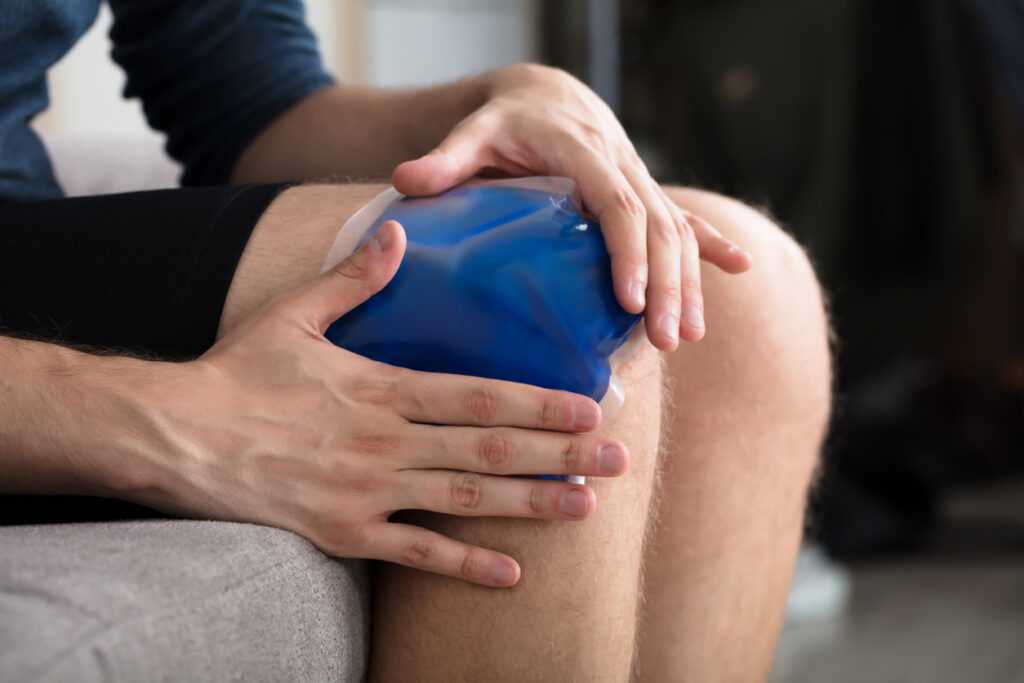
by Emily Lemiska
A warm, soft heating pad wrapped on a tight shoulder. A crisply chill ice pack against an aching knee.
Heat and cold therapies are widely recognized for their use with acute injuries, but they are sometimes overlooked as an option for chronic pain.
Last year, a survey from the U.S. Pain Foundation revealed that heat and cold therapy is actually the most-used relief option for people with chronic pain. Of the nearly 1,600 respondents, 67.8% said they use heat at least once a week, while 44.9% said they use cold therapy at least once a week.
But how do they work, what are the options, and when should they be used?
How heat or cold therapy works for chronic pain
Cold therapy decreases the temperature of skin and muscle, which reduces blood flow and metabolic processes. This, in turn, reduces inflammation and swelling, helping reduce pain.
Heat therapy, on the other hand, increases the temperature of skin and muscle, along with blood flow and metabolic processes. This improves healing and elasticity, thereby helping reduce pain.
“Both types of thermotherapy have important uses,” says Edgar Ross, MD, Director of the Pain Management Center at Brigham and Women’s Hospital. “What’s key is that you use heat and cold therapy as a gateway therapy, not a passive one.”
Ross says patients should “try to use them to support increased and gentle movement, which helps reduce pain over time and get you out of the vicious cycle of pain and decreased function and then more pain.”
As an example: you might apply ice after walking if your hip bothers you or use heat before walking to help warm up the joint.
Types of heat and cold therapy for chronic pain
Whether you choose hot or cold therapy for pain, there are many different delivery methods. Each has pros and cons related to efficacy and convenience.
Common types of heat therapy include:
· Topical gels or creams with compounds like capsaicin
· Powered heating pads, blankets, or wraps (sometimes portable)
· Hot baths, showers, hot tubs, and saunas
· Physical therapy-based heat, like ultrasound
Heat therapy options can also be categorized as moist or dry heat—you may find one or the other is more useful depending on your type of pain. Dry heat includes things like heating pads and even some saunas. Moist heat involves heat combined with moisture, like steamed towels or hot baths.
Delivery methods for cold therapy for chronic pain include:
· Topical gels or creams with compounds like menthol
· Ice packs or wraps
· Cold or ice baths or showers
· Cryotherapy
Cryotherapy is a newer option but is increasingly popular. It involves spending a short amount of time in a freezing or near-freezing chamber.
When to use heat or cold therapy for chronic pain
Cold therapy is typically recommended for pain that is associated with swelling and inflammation. It is most often useful for painful joints, including knees, shoulders, and elbows.
Hot therapy, on the other hand, is best for areas that are affected by stiffness and tension—like sore or spasming muscles. Many find it helpful for neck, back, and shoulder pain especially, but it can also be used on other joints.
But that doesn’t mean they are mutually exclusive. You may find using them in combination with one another—using heat in the morning, and ice at night—provides the most benefit.
In U.S. Pain’s survey, roughly half of respondents (52.6%) said they found heat more effective, while 18.7% preferred cold, and one-third (28.7%) said they were about equal.
A majority said they primarily use heat and cold “while having pain, as a way to manage or reduce it,” (62.5% and 50.6%, respectively), though some individuals used it both as a preventative and while having pain (47.3%).
When not to use heat or cold therapy
Like with all therapies, there are precautions to take when using heat and cold therapy. For example, neither therapy should be applied to open wounds. Cold therapy should be avoided if you have poor circulation, and heat therapy should be avoided if you have an infection in the region where it’s being used.
Generally speaking, each type should always be used as directed by your doctor or by the product manufacturer. Applying too much heat or too much cold—or using either for too long a period of time—can result in skin or nerve damage, like burns or frostbite.
“People can fall asleep using heat or cold therapy or make the mistake of using it while taking sedatives,” says Ross. “They are incredibly low-risk therapies, but you still need to be careful.”
In addition, you may want to avoid both types of therapies if you have any type of sensory processing disorder or nerve damage that might make it hard to sense if something is too cold or too hot on your skin.
The takeaway
With the high costs and side effects that come with many treatments for pain, heat and cold therapy remain a foundational part of any pain management plan. They’re especially important because they can be used at home, at your convenience and discretion. Even if you don’t own a specific product, you can always grab a bag of frozen peas or heat up a hot towel.
What type you use, and how and when you use it, may vary—but it’s likely to provide at least some degree of relief.
To learn more about our Pain Awareness Month initiative, click here.
Our 2021 Pain Awareness Month campaign is made possible through the generous sponsorship of Sunbeam®.
